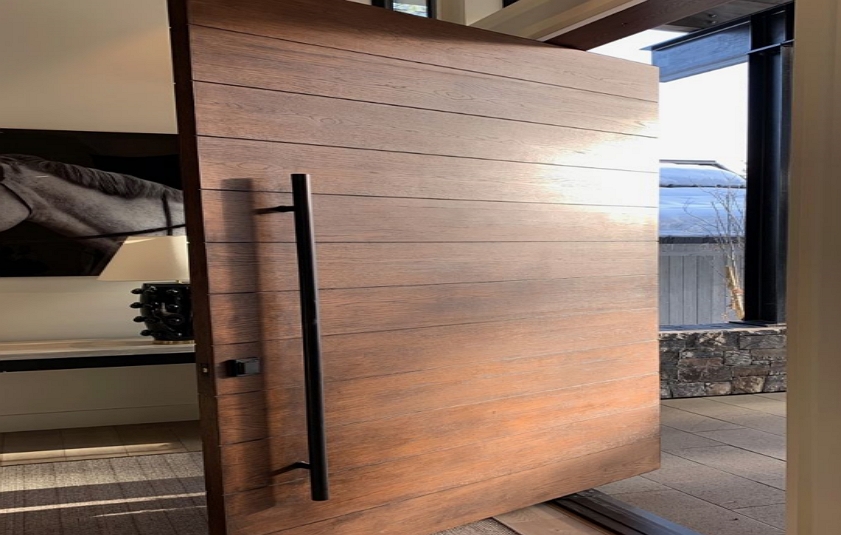Swivel doors are a type of door that can be opened and rotated on a horizontal axis. In the past, these types of doors were used primarily in commercial buildings such as grocery stores or warehouses to allow large items like refrigerators or barrels to pass through them without having to open the entire doorway.
Recently, however, they have also been seen in residential homes due to their convenience and aesthetic appeal.

The following article discusses what swivel doors are and what they mean for your building: what you need to consider before installing them, what kinds there are available on the market today, how much it costs to install one at home, and whether this style is right for you!
How does a swivel door work?
A swivel door is a type of entrance that rotates horizontally to allow passage through the doorway. Unlike swinging doors, they can be used for both interior and exterior entrances due to their ability to rotate in either direction which makes them more flexible than traditional hinges or sliding doors.
What do I need before installing one?
Before installing a swivel door, you need to make sure your home is properly prepped for installation. You’ll want to have an even surface to ensure that it will work effectively and be able to open and close smoothly without any problems.
What are they made of?
The majority of them are constructed of a metal frame with swinging casement doors.
What are the benefits?
They’re easier to use than traditional hinges or sliding doors: what happens if you have children, pets, and elderly members of your household who can’t walk through standard openings very easily? Swivel doors make it easy for everyone in the house to be able to move in and out of the house with ease.
They’re safer: what if you have a family member who’s elderly or has mobility issues? Swivel doors make it easier for them to get around without any help from others. You’ll never have to worry about someone getting stuck on the other side of a door, or what happens if they can’t get back in.
They’re more energy-efficient: what is the point of installing windows and doors that don’t allow outside air into your house? Swivel casement doors have a small gap around them which allows for the circulation of fresh air to keep your home healthy and happy.
No matter what time of day it is, you’ll be lighting up your interior with natural light: what if the sun goes down before all-day illumination? Swivel casement doors will let in an incredible amount of sunlight during the day and some even have built-in lamps.
What is the difference between a hinged and pivot shower door?
Hinged shower doors have a top and a bottom portion that swing inwards on hinges. Pivot shower doors are what you’ve seen if you’ve ever been to an old-fashioned hotel or toured the White House – they’re made of one piece with one side swinging outwards, often with a small door at the end (for those who need a bar or cane to walk).
How do I measure for a pivot shower door?
Measure the distance from the outermost edge of your home, where you will position the hinges on one side (typically 56 inches) and then place an additional two feet. This measurement should be what is indicated as “center” when ordering online.
The distance between the hinges is what will be measured from your hole and should typically come to about 44 inches.
What type of shower door is best?
The best type of shower door is what is most functional for you. You don’t want to buy a custom or semi-custom door only to find out that it doesn’t fit your space, and sliding doors are more expensive than bi-fold doors.
What is the difference between hinged and pivot?
A hinged door can be positioned as an outward or inward swinging door, while a pivot is what you typically find in most high-end shower enclosures.
The swing direction for the hinges on the wall panel is what dictates which will work best for your application.
How do you fix a pivot door?
If the pivot door is becoming stuck or getting off its track, you can use a lubricant to make it move more freely.
You may also need to adjust and tighten screws on the top of the frame for your shower door to close properly.
Keep in mind that these hinges will wear over time so there will be some maintenance needed to keep them running smoothly.
Consult with a professional before attempting any repairs on your own.
What are the benefits of pivot doors?
Pivot doors provide more space for entry and exit than what you find in exterior swinging hinged door applications, which means there’s less chance that someone will get “doored” by a passerby.
Pivot doors are ideal for wheelchair access as they allow the user to continue turning after 90 degrees of rotation and do not require an area in front of them to open, whereas with swinging hinged door applications users must find enough space to pull their chairs out before exiting from what’s essentially a doorway.
Pivot doors can also be applied to what is known as “gaps” in buildings, where the main building entrance is on one side of a gap and there’s an access point for wheelchair users or other people with accessibility needs on the opposite side – this way wheelchairs will never have to cross paths with any pedestrian.
